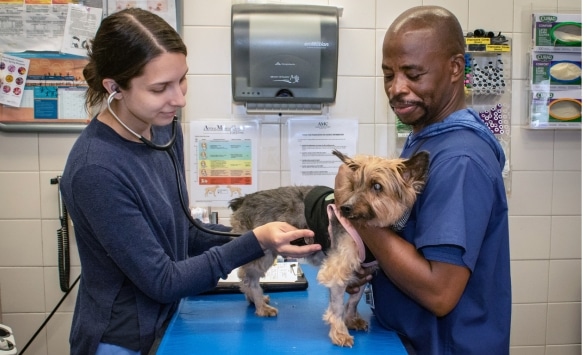Hypothyroidism in Dogs
Background
Hypothyroidism in dogs is typically the result of inflammation or shrinkage of the thyroid gland. The thyroid gland, located in the neck, is responsible for producing hormones that regulate the body’s metabolic rate, or how much energy the body uses to keep cells and organs functioning. In hypothyroidism, the thyroid gland does not produce enough thyroid hormone, leading to a lower metabolic rate. This hormone deficiency and lower metabolic rate affects the function of multiple organ systems to varying degrees. Hypothyroidism is the most common hormonal imbalance in dogs. This condition is most frequently seen in dogs aged 4 to 10 years and tends to occur in medium and large breed dogs.
Risk Factors
The cause of canine hypothyroidism is the destruction of the thyroid gland either by an iodine deficiency or a genetic component, with the following breeds more prone to developing the condition:
- Airedale terriers
- Boxers
- Cocker spaniels
- Dachshunds
- Doberman pinschers
- Golden retrievers
- Great Danes
- Irish setters
- Miniature schnauzers
Signs
There are a wide range of signs that may indicate the development of hypothyroidism, many of which are related to the slowing metabolic rate. Signs of hypothyroidism may include:
- Shedding or thinning fur (typically on the trunk of the body or tail)
- Thickening or puffy skin, particularly around the face
- Skin infections – scaly or smelly skin due to excess oil on the coat
- Skin darkening around armpit, groin, or areas the skin rubs together
- Ear infections – inflamed or smelly ears
- Lethargy and reluctance to exercise
- Weight gain without increased appetite
- Trouble keeping warm
These signs develop gradually and initially may go unnoticed. For this reason, it is important to take your dog for regular veterinary visits where a physical examination and annual blood tests can help identify hypothyroidism early. Common blood test abnormalities in hypothyroid dogs include anemia and elevated blood cholesterol.
Diagnosis
The diagnosis of hypothyroidism is based on identifying a combination of the clinical signs outlined above, exclusion of other diseases associated with these clinical signs, and blood tests showing decreased thyroid hormone levels, particularly of the hormone thyroxine (T4). It is not enough to test the level of thyroid hormones alone as there are factors that can affect the results. For example, sick dogs may have falsely low thyroid hormone levels. Certain dog breeds, such as Greyhounds, Irish wolfhounds, Whippets, Scottish deerhounds, and Alaskan sled dogs, have naturally lower T4 levels compared to others. Your veterinarian will also need to consider if your dog is already being treated for another disease or condition as certain medications can reduce thyroid hormone levels. These include:
- Anti-seizure medications
- Prednisone or other steroids
- Certain nonsteroidal anti-inflammatory drugs (NSAIDs)
- Propranolol (heart medication)
- Clomipramine (behavior medication)
- Antibiotics (sulfa class)
Your veterinarian may need to run multiple tests to confirm the diagnosis.
Treatment
As there is no cure for hypothyroidism, treatment is lifelong but the disease is easily managed with daily oral medication. Successful treatment will generally result in increased energy levels after the first week, and changes to the coat and bodyweight within a few months. Your veterinarian initially will need to monitor your dog’s hormone levels every 4 to 8 weeks in case the hormone dosage needs to be adjusted.
Make an Appointment



Internal Medicine
AMC's board-certified specialists in Internal Medicine treat small animal pets in specialty areas, such as: endocrinology, gastroenterology, hematology, immune-mediated disease, infectious disease, nephrology, reproductive medicine, respiratory medicine, and more.
Learn More































